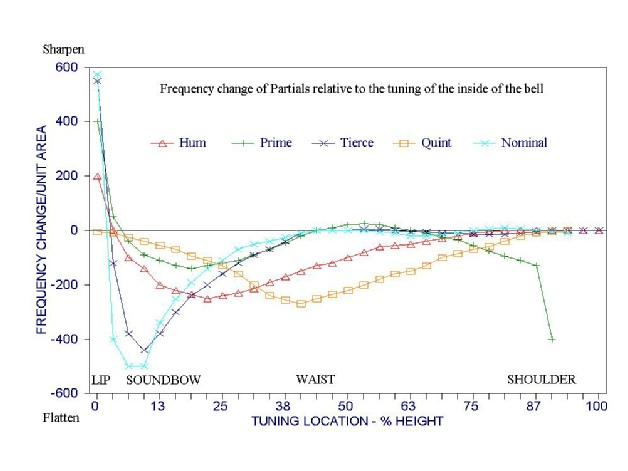


UK Registered Charity Number: 1154107

Conservation by Re-use
Helping churches acquire surplus and/or redundant bells to be hung for
English-style full-circle bell-ringing.


 Index
Previous page
Next page
Index
Previous page
Next page

Sound of Bells – Tuning
Providing there is sufficient thickness, the partials may be slightly changed in frequency by removing metal from the bell. Equation 1 shows the frequency will decrease as the thickness reduces. However this is a "general" equation and it is possible to slightly increase the frequency of certain partials by cutting back the rim of the bell (skirting). The bell tuner's skill lies in knowing which part of the bell to tune to achieve the desired result. The bell's shape and thickness are the main limiting factors, and these greatly restrict what can be achieved. The graph shows the results of research by E. W. Van Heuven6 of the tuning of a Hemony9 profile bell. The x-axis is the tuning position as a function of height, where 0% is the lip and 100% is the upper crown. The y-axis is tuning effectiveness, and should only be used as a comparison between individual partials.
Positive numbers for the y-axis indicate an increase in frequency (sharpen) and negative numbers a decrease (flatten). It can be seen that there are few places where a partial can be tuned without affecting other partials.
This is perhaps not surprising as the tuning function will be directly related to the locations of the nodal and anti-nodal circles (see figure 3). The graph shows that tuning the lip of the bell will sharpen the Nominal, Prime and Tierce. Tuning the soundbow will flatten the Nominal and Tierce and to a lesser extent the Hum and Prime. Tuning between the soundbow and mid-waist will have a greater effect on the Hum than the other partials. Tuning the mid-waist will have a great effect on the Quint with little effect on the Nominal, Prime and Tierce. Tuning the shoulder will flatten the Prime with little effect on the Nominal, Tierce, Quint and Hum partials.
Graph showing Tuning Effectiveness